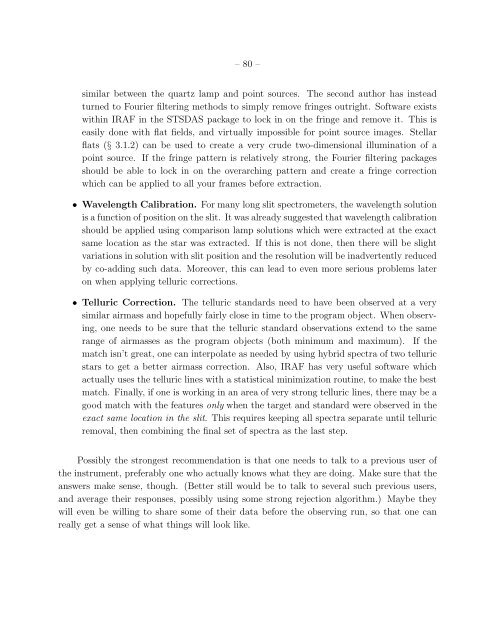Astronomical Spectroscopy - Physics - University of Cincinnati
Astronomical Spectroscopy - Physics - University of Cincinnati
Astronomical Spectroscopy - Physics - University of Cincinnati
Create successful ePaper yourself
Turn your PDF publications into a flip-book with our unique Google optimized e-Paper software.
– 80 –<br />
similar between the quartz lamp and point sources. The second author has instead<br />
turned to Fourier filtering methods to simply remove fringes outright. S<strong>of</strong>tware exists<br />
within IRAF in the STSDAS package to lock in on the fringe and remove it. This is<br />
easily done with flat fields, and virtually impossible for point source images. Stellar<br />
flats (§ 3.1.2) can be used to create a very crude two-dimensional illumination <strong>of</strong> a<br />
point source. If the fringe pattern is relatively strong, the Fourier filtering packages<br />
should be able to lock in on the overarching pattern and create a fringe correction<br />
which can be applied to all your frames before extraction.<br />
• Wavelength Calibration. For many long slit spectrometers, the wavelength solution<br />
is a function <strong>of</strong> position on the slit. It was already suggested that wavelength calibration<br />
should be applied using comparison lamp solutions which were extracted at the exact<br />
same location as the star was extracted. If this is not done, then there will be slight<br />
variations in solution with slit position and the resolution will be inadvertently reduced<br />
by co-adding such data. Moreover, this can lead to even more serious problems later<br />
on when applying telluric corrections.<br />
• Telluric Correction. The telluric standards need to have been observed at a very<br />
similar airmass and hopefully fairly close in time to the program object. When observing,<br />
one needs to be sure that the telluric standard observations extend to the same<br />
range <strong>of</strong> airmasses as the program objects (both minimum and maximum). If the<br />
match isn’t great, one can interpolate as needed by using hybrid spectra <strong>of</strong> two telluric<br />
stars to get a better airmass correction. Also, IRAF has very useful s<strong>of</strong>tware which<br />
actually uses the telluric lines with a statistical minimization routine, to make the best<br />
match. Finally, if one is working in an area <strong>of</strong> very strong telluric lines, there may be a<br />
good match with the features only when the target and standard were observed in the<br />
exact same location in the slit. This requires keeping all spectra separate until telluric<br />
removal, then combining the final set <strong>of</strong> spectra as the last step.<br />
Possibly the strongest recommendation is that one needs to talk to a previous user <strong>of</strong><br />
the instrument, preferably one who actually knows what they are doing. Make sure that the<br />
answers make sense, though. (Better still would be to talk to several such previous users,<br />
and average their responses, possibly using some strong rejection algorithm.) Maybe they<br />
will even be willing to share some <strong>of</strong> their data before the observing run, so that one can<br />
really get a sense <strong>of</strong> what things will look like.

















